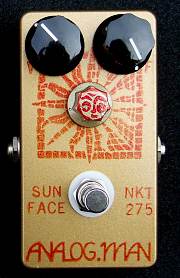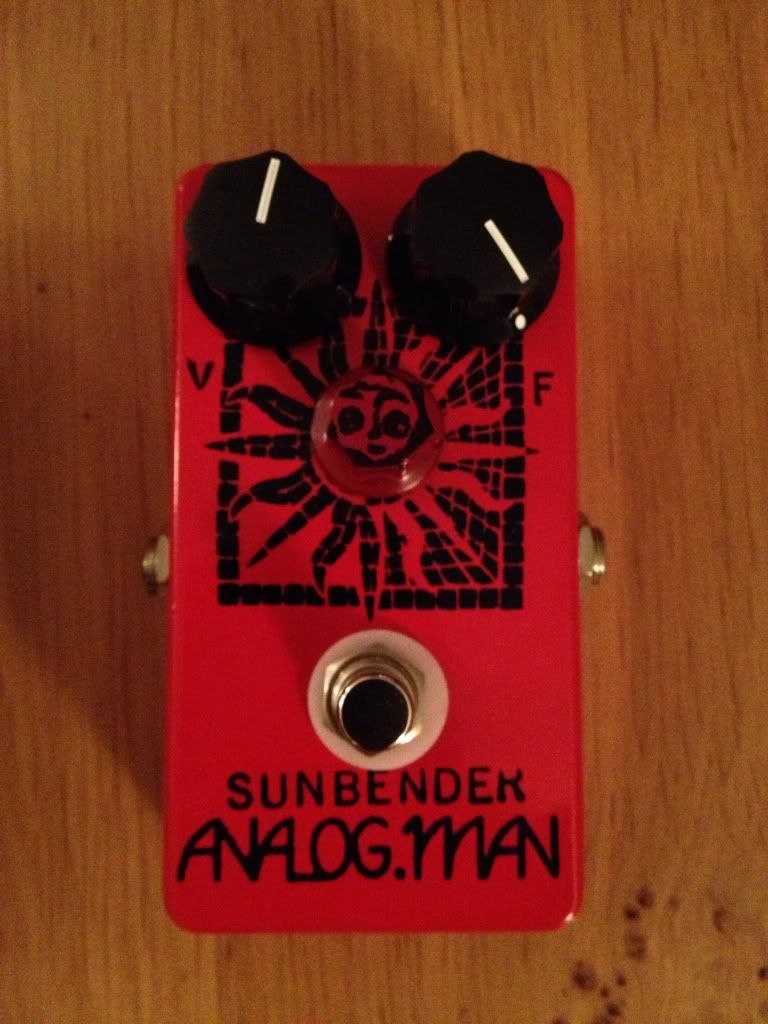Some people find themselves asking the question, "why fuzz?". They feel like it's an unnecessary effect that's too specialized and doesn't have as wide an application as something like distortion. That may be true, but fuzz, in my opinion, is one of the most dynamically responsive and important effects one owns as a guitar player. It goes together perfectly with tube amps, and it can really define your sound. Once you try one of the options I have listed below, you'll fall in love with the sound of fuzz, and never want to part with it.
First off, let's get this straight. Fuzz is NOT distortion, it's FUZZ. Rather than attempting to emulate an almost super overdrive with unimaginable sustain, it adds a softer clipping and almost a more natural sound, especially when blended with the amp's clean signal by means of the volume control. That is all on the subject of clarification, so now here's a few basic guidelines as to the method of selecting your fuzz pedal:
1. Play around with the guitar's volume control: one of the very interesting characteristics of fuzz pedals is that if you turn down your volume control on your guitar while the fuzz unit is engaged, it removes some of the intense fuzz and replaces it with your guitar's clean signal. This is what Jimi Hendrix did on a lot of his signature tracks like "Castles Made of Sand" and "Come On (Let the Good Times Roll)".
2. Check out all the controls: more generally, a fuzz will have just a volume and a fuzz control, and sometimes a tone control. This isn't always the case, however, and if it's not, make sure that the controls actually do something good to the sound, and that they have plenty of headroom (range of operation).
3. Play LOUD: but really, play to the point where you feel your face start to melt. The store owners will understand, because they know too that when you try out a fuzz pedal, it needs a strong base of fundamental amp tone to work with before it can really work it's magic. That's why some people hate fuzz, because they've never used it right, and it sounds thin and awful at a low volume.
There's a lot of fuzz pedals out there, and not all of them sound great, but a lot of them sound pretty good, so it's hard to go wrong. However, if you play a certain fuzz pedal that you heard Jimi Hendrix played (a fuzz face), and then find out that it sounds terrible, try another fuzz face. Each of these units has two transistors, silicon or germanium, that are important in determining the tone. Some companies don't gain test their transistors to make sure they are the right levels, so their fuzz pedals all sound radically different. Jimi actually would have his roadie go pick up six or seven fuzz pedals, daisy chain them together in a flurry of quarter inch cables, and test each unit individually to see which one sounded the best. Chances were at least three or four would get thrown out because they sounded so bad.
On the subject of the fuzz face, let me say this. DON'T BUY ONE. If you google "fuzz face", you'll come up with a list of pretty cool looking round pedals that look like they're smiling at you. Beware, because these aren't real fuzz faces, these are Dunlop reissue fuzz faces. Dunlop is a good company, don't get me wrong. Their reissues of the MXR pedals are some of the best stompboxes around, especially for the right price. When it comes to fuzz faces, though, they aren't nearly as good as some of the other options on the market. The circuit used is much different from that of the original Dallas Arbiter fuzz face used by guitarists such as David Gilmour, Eric Clapton, and Jimi Hendrix. As for other fuzz reissues, like to Tone Bender MKII, you should be fine purchasing them, because they are made truer to their original designs.
There's not a lot more to say on the subject of fuzzes as a whole, so let's see some of the best fuzz pedals available to buy today.
1. The AnalogMan Sun Face- $220 (various models can cost more or less)
If you like Jimi Hendrix, or David Gilmour, or Eric Clapton, or almost any other guitarist out there, this fuzz is the best. Made by AnalogMan, the quality of the components used is unbeatable, and the whole thing is made almost to exact 1960's specifications. Available for upgrade is a "Sun Dial" knob, pictured above, which allows you to dial in the correct bias for the climate you are in, as germanium transistors can be finicky. It's hard to find a place to try these, because they are so custom tailored to the player who orders them, but if you get a chance, try it out even if you aren't planning on buying a new fuzz. They are expensive, but for old fuzz face sounds, they're the best out there.
2. The Proco Rat- $90
I remember walking into Guitar Center a few years ago, going to the guy at the front desk and asking him this- "Do you have a pedal that will make my guitar sound like a harmonica?" He gave me this strange look, and then handed me a RAT, saying, "I think this is the sound you're going for." Sure enough, it was, and it has been since. This is the pedal that I keep on my board. It's cheap, it's built like a tank, and it sounds something like Jimi Hendrix playing Nirvana songs through a 500 foot tall Marshall stack, whilst descending down from the heavens on a flying saucer. That's to say that it sounds like nothing else, and that's a good thing. It's got three easy controls, and can do anything from crunchy boost sounds to a veering on uncontrollable fuzz. It's a very thick fuzz, and when you hear one you know it's a RAT immediately. This was used by players like Jeff Beck, David Gilmour (On "The Division Bell"), and Kurt Cobain. Because it's one of my favorites, you should go check it out and maybe pick one up for the inexpensive price they go for.
3. The AnalogMan Sunbender MK1.5- $265
I wasn't going to put ANOTHER AnalogMan fuzz up here, but AnalogMan is so cool they had to have TWO of the greatest fuzzes of all time in their lineup! This is a replica with some modern modifications of a Sola Sound Tonebender. If you don't know what that is, it's the fuzz pedal that Jimmy Page of Led Zeppelin used for his signature tones on Led Zeppelin I and II (and potentially others throughout the band's career). It sounds great, like a fuzz face but much brighter and punchier. It's made with the stuff of the gods, hence its not so flattering price-tag, but if you don't own a good fuzz already then this one is a great candidate for your first fuzz, not to mention a great addition to your collection of fuzz pedals. It's uses aren't quite as wide as some of the others listed here, but to be honest it sounds better for what it does than fifty percent of the pedals I'm going to talk about here. It's an AnalogMan though, so that's to be expected. So yeah, great fuzz, super cool, Jimmy Page used it.
4. Electro-Harmonix Big Muff- $80
In all of it's shapes and forms. First off let me say this pedal is a great fuzz. It's also got a history, and was produced in a few different locations with different components. The one I like most of all of these is the "Sovtek" Russian made Big Muff (the green one). If you can get your hands on one of these, go for it, they're really cool and sharp sounding. The vintage ones are great; David Gilmour used these for many of his recordings after Dark Side of the Moon (he used to use a Silicon Fuzz Face). Jack White, of the White Stripes, The Raconteurs, and his solo work under "Jack White" uses one of these as well, but the modern version. The modern version is good (and dirt cheap for how good it sounds), but it's not as good as the older and Sovtek ones. Nonetheless, a great fuzz, especially if you have a tube amp that you can play LOUD.
Here's some others I won't go into detail about, but I do enjoy playing:
-Way Huge Swollen Pickle
-MXR Blue Box (Vintage or Reissue)
-Vintage Fuzz Face/Tonebender/Supa Fuzz/Maestro Fuzz/Foxx Tone Machine
-Keeley Fuzz Head
Well, that's about it for fuzz pedals. Comment with any questions (I'll be glad to answer) or hate (I'll be glad to tell you why you're wrong)!






No comments:
Post a Comment